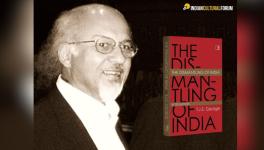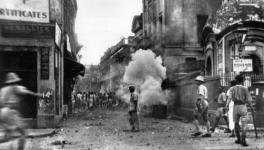Does Politics Lurk Behind the Hats PM Modi Wears?
Prime Minister Narendra Modi is known for his sartorial adventures, but on Sardar Vallabhbhai Patel’s 145th birth anniversary on 31 October, he gave his outfit an unusual touch. He wore a panama hat over his standard kurta-churidar while attending events of the day, from addressing IAS probationers and inaugurating a seaplane at the tallest statue of Patel (which he had commissioned as Gujarat chief minister) to standing at the feet of the statue and peering, mask-less, at a fully-integrated nation. (It is BJP’s claim that after the abrogation of Article 370 last year, Iron Man’s dream was fulfilled.)
Modi’s sartorial choice should be taken seriously. For, against Sardar Patel’s statue clad in a cultivator’s attire—loose dhoti-kurta and shawl over shoulders—and his own kurta-pyjama, it struck an odd contrast. The choice of attire is perhaps explained by the BJP and Modi’s politics and their connection to Sardar Patel’s background. Patel’s father was a farmer, and, according to the traditional varna hierarchy, he belonged to the Shudra category. As we know, Modi’s family also has a small-business heritage from the same state, Gujarat. The social groups categorised as Other Backward Classes by the Mandal Commission also fall in the Shudra category, such as the Patel, Jat, Maratha, Gujjar, Yadav, Kamma, Reddy, Nair, Lingayat, Nayakar and Mudaliar caste groups in different states. In other words, by today’s yardstick, Sardar Patel would probably be viewed as an OBC leader on the national stage.
Many would say the Prime Minister’s frequent costume changes represent his vanity, but aspirational Sudra/OBC voters, who are seeking a new identity for themselves in Indian politics, may also see in Modi’s dress codes a colourful version of nationalism. Therefore, it assumes significance that the Prime Minister has snatched Patel and his legacy from the Congress party and co-opted him into the NDA fold. In fact, the Congress seems to have relinquished control over Patel. For example, it is Modi’s followers who wrote in the national (English language) press and in regional newspapers about Patel’s greatness during the recent anniversary. They also appeared on TV channels to speak about him. Modi’s new iron lady follower, Kangana Ranaut, celebrated Patel’s anniversary by launching twitter attacks on Mahatma Gandhi and Jawaharlal Nehru and praising Patel to the skies. In the Telugu press, two key articles were written; by Himachal Pradesh Governor Bandaru Dattatreya and Minister of State for Home Affairs G Kishan Reddy. (Both belong to the Shudra/OBC category.)
It is another matter that BJP leaders have forgotten Patel’s real legacy, which was to organise farmers and fight for their rights. Ever since the Centre passed three over-centralising farm laws, farmers across the country have been agitating, but they have no Patel by their side, nor any of Patel’s modern-day followers.
We must also recall that even within the ranks of the RSS and BJP, nobody fully understood why Modi had built the tallest statue for Patel and not Syama Prasad Mookerjee or Deen Dayal Upadhyay, two icons that the Hindu right can claim as its own. Perhaps Modi’s choice of wearing a western-style hat can offer an explanation: they are part of his attempts to identify himself with Patel and build him into an icon, but the overall aim is to influence aspirational OBC voters, who, Modi’s party hopes, would be drawn to his flamboyance.
Like the BJP on the national stage, the regional parties that represent Shudra/OBC interests in states do have the capacity to independently mobilise votes within their regions and states. They are in sufficient numbers to combine and change the outcome of any popular election. No doubt, in North India, the political forces representing these sections have been weakened by the BJP’s growing hegemony. However, they are trying to regain their strength in time for the 2024 general election.
So, the actual mystery is why the Congress refuses to use portraits or cut-outs of Patel in its election campaigns. It would, after all, need Shudra/OBC voters too—of whom a large number have migrated to the BJP over the last two election cycles. Patel would have been a natural choice for the party to prop up; a national leader who can represent Congress party’s future plans and be remoulded for aspirational Shudra/ OBC youth; even as a counterpoint to the BJP-RSS’s aggressive nationalism.
Instead, the Congress’s campaign cut-outs consist of Gandhi, Nehru, Indira Gandhi, Rajiv Gandhi, Sonia Gandhi and Rahul and Priyanka Gandhi. Obviously, in this family pack there is no Shudra/OBC leader. Modi has been calling out this parivar pack at national and state-level elections, and the rhetoric against family rule does appear to be influencing a section of voters.
When it comes to regional parties, the problem is they, too, are family affairs—and therefore, like the Congress, caste affairs—and during elections they propagate campaign material and cut-outs primarily of their families. Meanwhile, it suits Modi that Sardar Patel’s family has been forgotten. After all, he has distanced himself from his own family, while Patel has nobody in politics or in the high-end intellectual circles, which Modi calls “Khan market gang” or “Lutyens club”.
In the Indian political pantheon, Gandhi is represented by his grandsons including well-known historian Rajmohan Gandhi, former Governor Gopalkrishna Gandhi and so on. Nehru’s genealogy in politics is being continued by Sonia Gandhi and her children. Along comes Modi, slowly turning himself into Patel’s grandson, wearing many hats to charm OBC youth, a raj rishi-type figure who rages against the Congress’ Harvard-educated dhoti-clad leadership, who signify those who look crumpled but possess plenty of wealth. In ten years as Prime Minister, Manmohan Singh dressed in the same pyjama-kurta and blue turban, not to forget his serious demeanour. Is it not true that he wrote on economic theory, but hardly a few know about these writings? He was, in a sense, a walking cut-out himself, speaking so softly that his voice hardly travelled beyond the ears of the Congress leadership. But Modi’s Mann ki Baat is full of glib sermons on economics, political science, sociology, geography, mathematics and whatnot, even as the real economy tanks—his high-pitched “bhaiyon and behno” echoes everywhere.
At yet another level, Modi’s panama hat was incongruous against the long white beard he now sports. But this incongruity is not a reflection of the PM avoiding the barber due to the Covid-19 pandemic. No—his current bearded appearance is meant to fan a crisis in the Rashtriya Swayamsevak Sangh leadership as well. He has started to appear more like a Hindu hermit, a contrast against the RSS chief Mohan Bhagwat.
The panama hat Modi wore is not an item of clothing normally accepted by the RSS. According to them, “western” wear does not represent Indian cultural nationalism. But it can represent youthful aspiration. Even during the freedom struggle, neither Congress leaders nor Hindutwadis were seen wearing panama hats. Then and now, if the Congress brand was the Gandhi topi, while the Hindutva cap was—and is—a semi-military saffron (now black) affair. The only leader who regularly wore a hat during the freedom struggle was Dr BR Ambedkar. He accompanied it with full western attire and the fact remains, he was often targeted for wearing his suit and hat, especially by those who stuck to the dhoti-kurta attire.
The author is a political theorist. His new book co-edited with Karthik Raja Karuppusamy, The Shudras—Vision for a New Path, is soon to be published by Penguin.
Get the latest reports & analysis with people's perspective on Protests, movements & deep analytical videos, discussions of the current affairs in your Telegram app. Subscribe to NewsClick's Telegram channel & get Real-Time updates on stories, as they get published on our website.
























